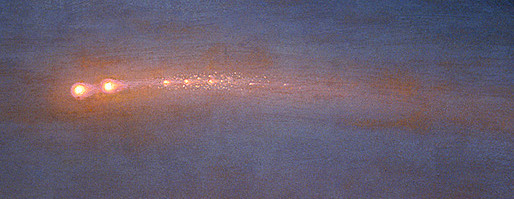Skayrrie
Skayrries are rogue clusters of ayrth carried on the gales. Gahls tremble at the warning cry of distant whistling winds, for these sling-stones cast by angry gods can splinter ayrship hulls and shatter ayrland reefcrusts. Gahls feel for the trembling of their alert chimes, and scurry for shelter. The rousing bells toll to confirm the approach. Clasher scouts reach for their grappling lances, mount their birds, and take wing to assess the skayrrie's size, and ayrstrogate its trajectory. The curious and paranoid gawk out their windows, as small aircraft are deployed with nets, tugging-winches, armor-piercing harpoons, and coil-powered pulverizers. However, for larger or more numerous threats, these tactics only lease time for the ironsides to get crewed and aloft. These heavily armored ayrships face down the onslaught, loaded with bombs and reefbuster missiles.
The stakes are critical, but the passing howls come too frequently to justify mobilizing the entire collision brigade in response to every near-miss and false alarm. Thus, for the sleepless saviors known as Clashers, the Skayrrieguard vigil is a constant burden. If you, dear reader, should ever find yourself in a working gahl's pub, and in need of a dauntless ally, or just a plain good story, seek for an emblem of crossed flail-cannons, and buy that comrade a drink. Aye, more, and many, for the weight of the world rests on their shoulders.
Just as botanists will debate themselves hoarse over the distinction between an herb and a weed, meteorologists have yet to declare a consistent measure to precisely discern a skayrrie from merely a small ayrland. It is an arbitrary thing often having to do more with perceived utility: Is that chunk of rock over there smaller than the one I'm standing on? Can I build on it to the comfort I'm used to? Or is it simply inconvenient sky trash, good for nothing more than harvesting materials? The trouble with the "I'll know it when I see it" approach is that many migratory species, as well as roaming tribal cultures, depend on small ayrlands for their survival. Oral history even recounts a few incidents in which developed nations destroyed a micro-ayrland with its inhabitants still aboard. Of course, you'll find such accounts curiously missing from the libraries of the victors.

